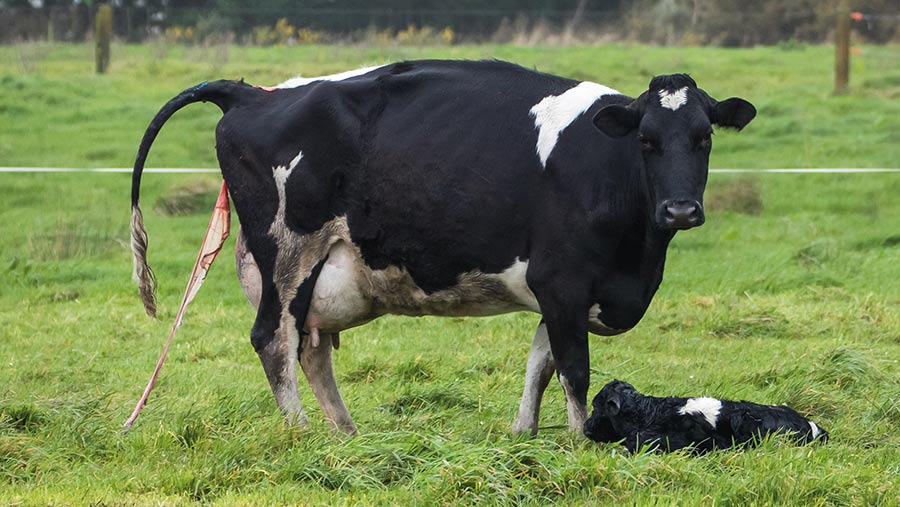Uterine disease in dairy cows: Symptoms, causes and reducing risk
 © Rghenry/Adobe Stock
© Rghenry/Adobe Stock Uterine disease in dairy cows is becoming more common. While all cows will have bacteria in the uterus, a staggering 40% will develop disease.
This is a huge issue affecting fertility, welfare and productivity, causing inefficiency and an increased carbon footprint.
The health of the uterus is vital for working towards another pregnancy within a target time.
See also: 5 expert tips on dairy transition management
About the author

Lara Robinson graduated from the University of Liverpool and works in farm animal practice with Daleside Veterinary Group.
Her particular interests are bovine fertility and herd health.
The fresh cow has a huge task ahead of her: her uterus must return to the size it was before pregnancy, the ovaries have to begin cycling and the cow needs to get in calf again, all within three to four months.
Uterine disease delays all of this, causing infertility during the period of the disease and risking sub-fertility for a long time afterwards.
It can be broadly classified into two categories: metritis and endometritis.
Metritis
Metritis is defined as an enlarged uterus with discharge containing pus found in the vagina within three weeks of calving.
It results in a lower milk yield, fewer pregnancies and increased culls. It is an expensive disease, costing up to £450/case.
Metritis can be graded:
- Grade 1 refers to an enlarged uterus with vaginal discharge. Temperature is normal and the cow is otherwise well
- Grade 2 also refers an enlarged uterus and vaginal discharge; however, the cow usually has a temperature, decreased milk yield and/or a reduced appetite
- Grade 3 is the most severe: cows show signs of toxaemia, they are dull, cold, and require intervention from your vet.
Unfortunately, treatment does have an effect on fertility. This is due to a combination of factors, including the time it takes for an egg to develop (about three months).
It is also because blood flows between the uterus and the ovary.
This means that even after treatment, fertility is not improved, because the egg that needs to be fertilised to establish a pregnancy has developed in the presence of toxins from an infected uterus.
These toxins result in a poorer quality egg and, as such, worse fertility outcomes.
However, metritis is a welfare concern, so it is important to recognise it and treat it appropriately. It is well worth discussing a treatment plan with your vet.
Endometritis
Endometritis is defined as discharge containing pus found in the vagina 21 days or more after calving. It affects about 15% of cows.
Endometritis can also be graded, from Grade 0, where there is no disease and vaginal mucus is clear, to Grade 3, which describes vaginal mucus with greater than or equal to 50% pus.
Endometritis is also an expensive disease, costing up to £260/case. Most of this cost is not for treatment but because of reduced fertility.
There are multiple different treatment options and not all treatments involve antibiotics. It is a good idea to discuss this with your vet.
When do bacteria cause disease?
Exposure of the uterus to bacteria immediately after calving is normal. However, not all cows develop disease.
In some cases, the bacteria that cause disease are part of the normal bacteria present in the reproductive tract; they live happily without causing a problem.
However, when that reproductive tract is damaged – for example, during an assisted calving – or the immune system of the cow is compromised – for instance, because of a negative energy balance – these bacteria can then cause disease.
Risk factors
Risk factors for uterine disease include:
- Retained foetal membranes
- Stillbirths
- Twins
- Assisted calvings
- First calving
- Mastitis
- Milk fever
- Male calves (because they are bigger).
How to reduce risk
We need to focus on reducing damage caused to the reproductive tract by avoiding assisted calvings.
We also need to improve the cow’s immune system to fight off infection and to tolerate bacteria and avoid disease.
Maintaining cows in the correct body condition score (BCS) is vital for transitioning cows well, reducing milk fever and reducing negative energy balance – all risk factors for uterine disease.
Ask your vet practice if they offer a BCS service through a vet tech and consider incorporating BCS at routine fertility visits with your vet.
To further reduce risk:
- Use easy-calving sires and more sexed semen
- Clean and disinfect calving boxes between every calving
- Avoid overstocking in communal calving areas and bed them properly
- If you have to assist a calving, wear gloves or at least wash your hands and arms thoroughly. The trick to assisting a calving is not to use brute force. Calving aids can be a useful tool, however, there is a skill to using them – ask your vet to show you
- Identify cows with a higher BCS or older animals with a higher risk of milk fever. You can then keep a closer eye on these cows around calving and provide extra care such as the use of calcium or transition cow boluses
- Keep stress caused by group movements, lameness, mastitis, overcrowding, heat stress and bullying of heifers to a minimum, as stress is a huge risk factor for a poorly functioning immune system.
Top tip for cutting the risk
The simplest thing you can do is to start recording cases of metritis and endometritis and discuss them with your vet.
Records are the key to working out what specific risk factors you have on your farm. A plan can then be agreed to reduce these risk factors.
